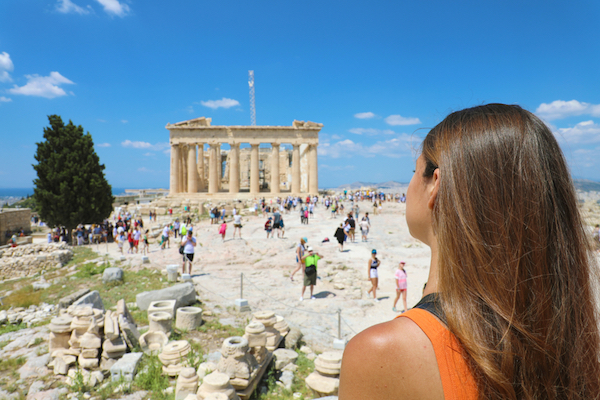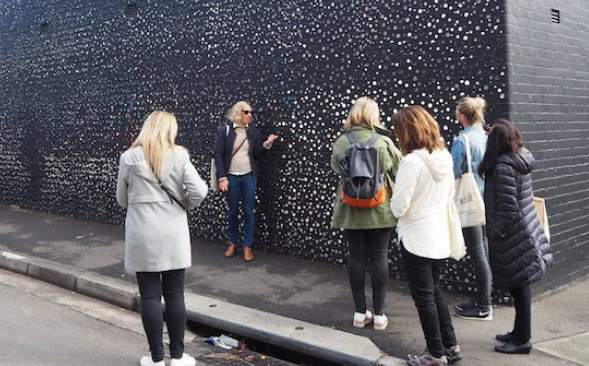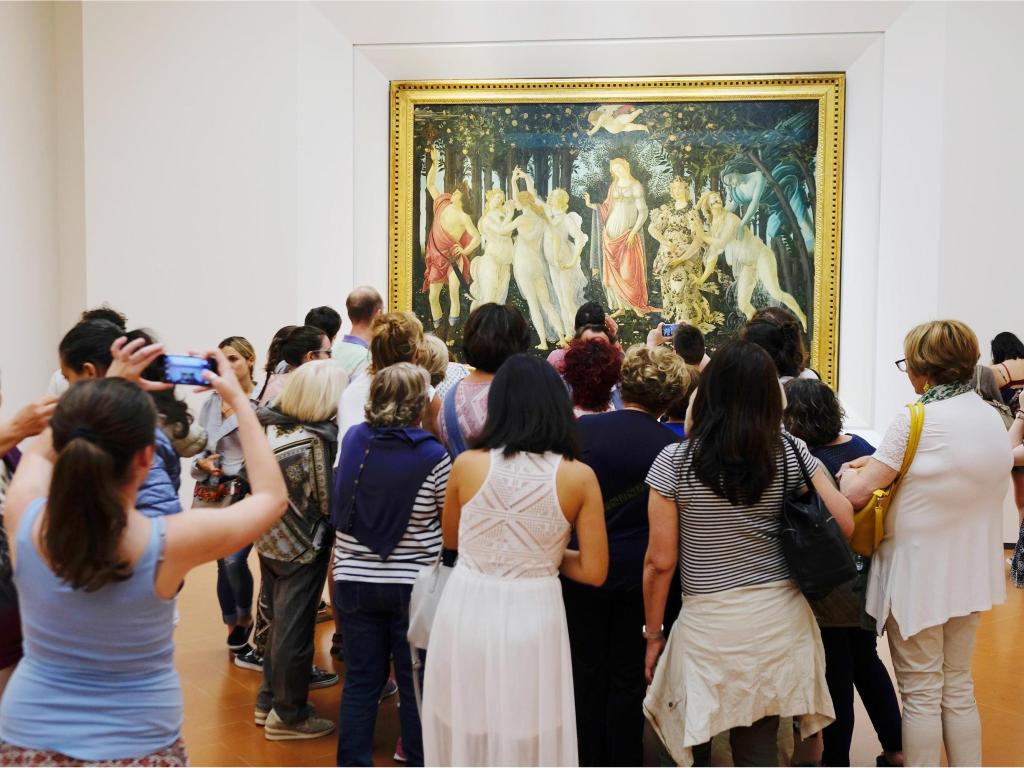Image shutterstock.com; cultural tourists crowd the Uffizi Museum, Florence; photo Vereshchagin Dmitry.
What has been touted as the new “it” thing in the tourism sector, Cultural Tourism, has been on a rapid and consecutive rise for decades now – so much so that the European Commission designated 2018 as a Year of Cultural Heritage.
While the cultural sector has been disruptive to traditional tourisms offerings, there has been a further shift particularly in the past decade as people’s demand for more bespoke cultural offerings have forced a rethinking of cultural and heritage tourism.
As cultural destinations globally have become strained under the numbers – those museums and monuments that are consumed by large numbers of people – visitors are looking elsewhere for their cultural fix, a trend in line with the rise of the experience economy and self-booked travel.
What is emerging is “creative tourism” – a new vein in cultural tourism where the experience is more one-on-one and is anchored in local culture. And key – the visitor takes away something more than just souvenirs and smart phone snaps.
It has busted open the market place, so that bespoke cultural offerings by independents, smaller organisations, through to new-to-market enterprises such as Airbnb Experiences, mean that cultural tourism is no longer just the domain of muscly majors, state assets and tourism brokers.
To coincide with World Tourism Day this week (27 September), ArtsHub takes a look at how the culture sector has had an increasing impact on tourism through an escalating demand for authentic creative experiences and better regional options.

Image shutterstock.com
Setting the cultural tourism scene
The United Nations World Tourism Organization (UNWTO) defines cultural tourism as trips with ‘the main or concomitant goal of visiting sites and events with cultural and historical value.’
UNWTO estimates that more than 50% of tourists worldwide are now motivated by a desire to experience a country’s culture and heritage, and according to UNWTO’s 2012 global survey, cultural tourism is forecast to increase by 15% year-on-year globally.
It identified six categories leading that rise and the foundations of cultural tourism’s success:
1. Handicrafts and visual arts
2. Gastronomy and culinary
3. Social practices, rituals, and festive events
4. Music and performing arts
5. Oral traditions and expressions
6. Knowledge and practices concerning nature
Regardless of whether an independent, a major or a regional culture provider, these target areas remain the same.
Turning to home, Australia Tourism Statistics (March 2018) showed that 1,004 people arrive into Australia every hour for tourism, bringing a $41.3 billion total international visitor spend in Australia in 2017 alone. The most travelled locations were Melbourne with 35%, Sydney at 30% and Perth with 27% of visitors.
Of all international visitors to Australia in 2017, 43% participated in a cultural activity and 33.9% in a heritage activity. Cultural and heritage segments have been growing at 7.5% and 11.2% respectively over the past four years.
Frequently rattled off, numbers such as these represent a huge opportunity for the arts, heritage and culture sector, but how do these organisations and independents better tap into tourism engines that promote assets to reap that impact?
It is a pressing question, especially when the arts sector is suffering from funding pressures, and a sideways flow from tourism would help cultural sustainability and visibility.
A spokesperson from Destination NSW told ArtsHub: ‘For our tourism operators, there’s no question that understanding their target market is key so that they can deliver on the travel preferences of their customers, and tailor their offerings to the experiences visitors are seeking.’
China, this year, took over New Zealand to become the largest source of both inbound arrivals and inbound spend.
Destination NSW added: ‘In terms of cultural factors, for international visitors, history and heritage ranks sixth in terms of the most important factors considered when choosing a holiday destination, with local festivals and celebrations ranking 19th and museums, art galleries and theatre ranking 20th. For domestic visitors, history and heritage ranks 11th, and arts and culture ranks 15th.’
There is still room for greater impact.
Australia Tourism Statistics made the point that while The Opera House is a UNESCO World Heritage Site, with 8.2 million people flocking to it every year, most tourists are only interested in the exterior design of the building, despite it being home to theatres, studios, a concert hall, exhibition rooms and a cinema. How do we get them through the door?
The rise of independents and unique cultural experiences
In the paper Tourism development trajectories – From culture to creativity? presented at the Asia-Pacific Creativity Forum on Culture and Tourism, in Korea (June 2009), Greg Richards unpacked this idea that tourism trends have moved from ‘culture’ to ‘creativity’. Nearly a decade later, his forecast appears to be reaping truth.
Researcher Paolo Russo (Venice, 2002) first verbalised the looming problem that historic city centres are suffering from a ‘vicious cycle’ of cultural tourism development, where the large numbers of tourists at famous sites had degraded the quality of experience and was starting to drive ‘serious’ cultural tourists away.
Richards wrote: ‘There are a growing number of places in search of new forms of articulation between culture and tourism which can help to strengthen rather than water down local culture, [and] can raise the value accruing to local communities and improve the links between local creativity and tourism.’
He called this new rise “creative tourism” – tourism that offers visitors the opportunity to develop their creative potential through genuine exchange and engagement with local people and local culture courses.
This requires not just creativity on the part of the tourist, but also the destination. This is the space where we have seen Airbnb Experiences emerge and companies like Sydney-based Culture Scouts.
Emily Fields Joffrion writes for Forbes magazine: ‘At the end of 2011, Airbnb was entering hyper-growth with 13 international offices and over a million nights booked in 182 countries.’ Rather than sitting back and enjoying the laurels, the company wanted to disrupt itself and keep its product market-fit.
Bringing in Rebecca Sinclair, Head of User Experience Research and Design, the company turned to storyboards and visualisation to map the tourism / client journey – and one of the results was Airbnb Experiences.
‘When we realised the product was the trip, we started to see Airbnb as a lifestyle company that could believably extend into more aspects of the trip, like Airbnb Experiences,’ said Sinclair.
It is a success story similar to that of Sydney entrepreneur, Emilya Colliver, who has been doing this since 2015, when she established her company Culture Scouts. It curates bespoke local walking tours that seamlessly blending food, art, artists studios, history and culture with local knowledge. They conduct between 500 – 600 curated art tours a year across Sydney neighbourhoods.
Colliver told ArtsHub: ‘Tourists are starting to look for something beyond the stereotypical Australian experience and, so in this sense, I do think it’s getting easier for tourism businesses who are promoting a different perspective.’

Culture Scouts offers bespoke tours under the growing demand for creative tourism; supplied
Colliver said that Culture Scouts had been well supported by the government bodies Tourism Australia and Destination NSW. ‘They’ve really seen the value in promoting cities and cultural destinations (beyond the beaches and outback that is so typical to Australian tourism),’ however she added that the challenges of a small arts business trying to gain weight in the tourism sector remains tough.
‘Being a small business, the challenge has often been about deciding where to spend my time and resources … especially when I’ve come from an Arts background and the tourism Industry was a new arena for me,’ said Colliver.
Read: How I became a culture entrepreneur
Colliver took Culture Scouts to the global tourism market last year, participating in the Australian Tourism Exchange (ATE17). For a small business that started just three years ago it is not the usual path to be doing media familiarisations with journalists from the New York Post, China Daily, The Guardian and Lonely Planet.
In an earlier interview with ArtsHub Colliver said: ‘For us to get to “export ready” we are now dealing with international journalists who are writing about Australia, and we are showing them places that locals go – and it is more culture and design focused! It is new material that hasn’t been written about before, and it is constantly changing.’
‘I am still trying to get my head around the language and trying to understand how the distributions channels work,’ she said. ‘We had a lot of industry people say to us, “Why are you going to ATE – it’s so early for you and it’s so much money?”, but you can’t listen to that. We know we are ready and everybody is so excited about our product we are offering.’
Miami artist Evoca1 for the PUBLIC Silo Trail, Pingrup, Western Australia 2018 – the last to be painted in a five year regional initiative; Photograph by Bewley Shaylor.
What are people looking for today?
A distinguishing aspect of cultural tourism is intangible cultural heritage – learning and experiences that you just can’t buy off the shelf like a souvenir.
Destination NSW told ArtsHub: ‘The latest data from Tourism Research Australia shows that visiting history and heritage buildings, sites or monuments is the most popular cultural and heritage activity undertaken by international visitors, followed by going to museums or art galleries, and attending cultural events.
The peak organisation added that nearly 17 per cent of all international travellers to NSW took part in an Aboriginal cultural tourism experience in 2017.
Similarly, as our regions have become culturally stronger, offerings of the “outback” are no longer exclusive to adventure-style enviro tourism.
Destination NSW reported that cultural and heritage visitors to regional areas accounted for a 52.6 per cent share of the total NSW cultural visitors to the State, an increase of 7.4 per cent on the previous year.
In August this year NSW Minister for Tourism and Major Events, Adam Marshall announced that the Government would work with industry to reach an ambitious target of $20 billion in visitor expenditure in rural and regional NSW by 2025, rising to $25 billion by 2030.
‘We’ve set the State’s first regional tourism target, so that every corner of NSW gets its fair share of the record tourist dollars and investment coming into our State,’ Marshall said.
‘Our current State-wide tourism target has Sydney as the heavy lifter getting us to number one. It’s now time to look beyond Sydney and do the work needed to turbocharge tourism in our rural and regional areas and double the current record levels of visitor expenditure,’ he added.
Destination NSW noted that their Flagship Event Fund is open for applications now to assist with such initiatives in regional cultural tourism.
NSW is not alone in this ambition. Creative VIC has also done a lot of research in cultural tourism sector, and we particularly see results in towns like Bendigo, Ballarat and the Mornington Peninsula.
Creative VIC’s targets and tracking are very clear: ‘In the year ending December 2017 there were 2.9 million international visitors to Victoria. 1.8 million of these, or 63%, were considered to be cultural visitors’, with 66% visiting museums or art galleries, 65% historical or heritage buildings, 24% for festivals and 23% participating in First People’s cultural activity.
Theatre, concerts or another performing arts activity sat at 19%, while participating in arts and craft workshop drawing at 14%. If we are to listen to the creative tourism noise, this is the growth category and is not exclusive to the majors or festivals.
How can the arts better capitalise on this trend?
The enormity of the tourism sector can seem daunting for smaller to mid scale cultural organisations and independents. Last year Create NSW (then Arts NSW) published their Cultural Tourism Toolkit to simple map-book to assist local assets on how to capitalise tourism potential and better package their offerings for market.
Similarly, National Trust of Australia published the excellent discussion paper (April 2018) at the National Heritage Tourism Summit to drive national discussion on the untapped potential of heritage tourism in Australia.
It points to storytelling as a new global trend. ‘Excelling in the art of storytelling and using innovative presentation skills to transport the visitor to a desired time and place is essential for heritage tourism attractions to compete on a global scale,’ states the paper.
Storytelling goes with bold vision and a can-do attitude. Colliver told ArtsHub: ‘I think that we need to encourage more collaboration between the arts and tourism sectors. I’ve found the tourism industry to be an overwhelmingly welcoming place, with loads of opportunities anyone with an innovative idea.
‘My advice is to be more open to non-creative partnerships, think about how your business/studio/gallery can benefit from having a presence in the tourism world,’ Colliver said.
Destination NSW also encouraged bold vision, especially in regional Australia: ‘The NSW Government has set the State’s first ever regional tourism target of $20 billion in visitor expenditure in rural and regional NSW by 2025, rising to $25 billion by 2030.
‘A key aspect of this, identified in our new Visitor Economy Action Plan, is growing Aboriginal cultural tourism, especially in rural and remote areas. Through a new inter-agency group led by Destination NSW, we’ll be looking at opportunities to continue our work in growing this sector, working closely with arts and cultural tourism operators and organisations across the State,’ said Destination NSW.
‘Destination NSW also offers the NSW First Program, which helps tourism businesses across the State promote, develop and sell their product. This includes opportunities for cultural tourism operators, and arts and cultural organisations, to access online resources and attend workshops to become export ready – a fundamental step for any organisation that wants to capitalise on opportunities to attract international visitors.’
Growing any business is a tough gig, especially when audiences are constantly diversifying. All this research and trending shows that the work can pay off, and that the potential is ripe. But it takes commitment and collaboration to pull it off. No matter how good your cultural or heritage offerings might be, unless you are visible to the tourism sector – to tourists themselves – then you will not get that phenomenal traction that might be just at the edge of your activities.
Bottom line is people travel more than ever today, and they are hungry for unique experience that they can curate themselves. Tap into those channels and turn creative tourism into your advantage.






